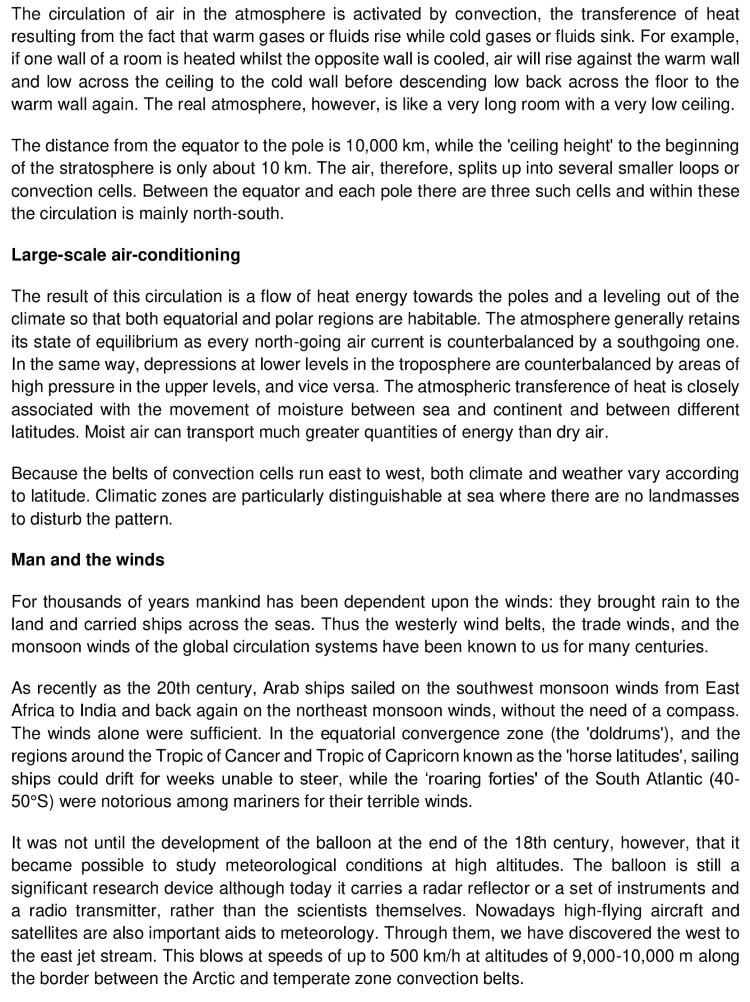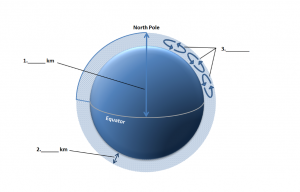Air Conditioning the Earth- IELTS Reading Answer
7 min read
Updated On
-
Copy link
Table of Contents

Limited-Time Offer : Access a FREE 10-Day IELTS Study Plan!
In the Academic Reading practice passage, “Air Conditioning the Earth”, there are various question types, each of which are asked in the IELTS Reading exam. Ideally, you should not spend more than 20 minutes on a passage. Let’s see how easy this passage is for you and if you’re able to make it in 20 minutes. If not, try more IELTS reading practice tests from IELTSMaterial.com.
Reading Passage
Air Conditioning the Earth


Questions 1-3
Label the diagram below. Choose NO MORE THAN TWO WORDS AND/OR A NUMBER from the passage for each answer. Write your answers in boxes 1-3 on your answer sheet.

Questions 4-7
- on land
- polar regions
- moisture
- heat
- balanced
- at sea
- offset
- pole
- equatorial regions
- latitude
- in the air
- longitude
Global air circulation spreads heat from the equator towards the 4____________ Generally, a state of balance in the atmosphere is maintained because the north-moving air currents are continually being 5________________ by the south ones. Within the system of heat transfer in the atmosphere, the climate is affected not only by 6 ____________but also by the amount of moisture in the air.
Questions 8-12
Write the correct letter, A, B, or C in boxes 8-12 on your answer sheet.
Classify the following wind patterns according to whether the writer states they are
A useful
B problematic
C neither useful nor problematic
8 ________ ‘roaring forties’
9 _________south-west monsoon winds
10 ___________west to east jet stream
11 _____________’horse latitudes’
12_____________ north-east monsoon winds
Question 13
Answer the question below.
Choose NO MORE THAN THREE WORDS AND/OR A NUMBER from the passage.
Write your answer in box 13 on your answer sheet.
Which border between convection zones determines the weather in the Northern Hemisphere?
13 ______________
Reading Answer
1 Answer: 10,000 Kilometers
Question type: Diagram Completion
Answer location: Paragraph 2
Answer explanation: Paragraph 2 states that the distance from the equator to the pole is 10,000 km. The distance from the North pole to the equator is 10,000 km. Thus, the answer is 10,000 kilometers.
2 Answer: 10 Kilometers
Question type: Diagram Completion
Answer location: Paragraph 2
Answer explanation: In paragraph 2, it is mentioned that the distance from the equator to the pole is 10,000 km, while the ‘ceiling height’ to the beginning of the stratosphere is only about 10 km. So, according to the diagram, it is clear that the ceiling height to the start of the stratosphere is about 10 KM. Thus, the answer is 10 Kilometers.
3 Answer: Convection Cells
Question type: Diagram Completion
Answer location: Paragraph 2
Answer explanation: Paragraph 2 states the fact that the distance between pole and equator is 10,000 kilometers, whereas the ceiling height is 10 KM. The air, therefore, splits up into several smaller loops or convection cells. Thus, it is evident that the splitting up of loops or conventional cells. Hence, the answer is convection cells.
4 Answer: B. Equatorial Regions
Question type: Summary Completion
Answer location: Paragraph 3
Answer explanation: Paragraph 3 states that the result of this circulation is a flow of heat energy towards the poles and a leveling out of the climate so that both equatorial and polar regions are habitable. These lines suggest that the global air circulation spreads heat from the equator towards the equatorial regions to make them habitable. Thus, the answer is B. Equatorial regions.
5 Answer: G. Polar regions
Question type: Summary Completion
Answer location: Paragraph 3
Answer explanation: In paragraph 3, it is mentioned that the result of this circulation is a flow of heat energy towards the poles and a leveling out of the climate so that both equatorial and polar regions are habitable. These lines indicate that the global air circulation spreads heat from the equator to the equatorial regions and polar regions. A state of balance in the atmosphere is maintained because the north-moving air currents are continually being polar regions by the south ones. Hence, the answer is G. polar regions.
6 Answer: J. Latitude
Question type: Summary Completion
Answer location: Paragraph 3, last line
Answer explanation: The last line of paragraph 3 states that the atmospheric transference of heat is closely associated with the movement of moisture between sea and continent and between different latitudes. We can understand from these lines that Within the system of heat transfer in the atmosphere, the climate is affected not only by latitude but also by the amount of moisture in the air. Thus, the answer is J. Latitude.
7 Answer: F. at sea
Question type: Summary Completion
Answer location: Paragraph 4
Answer explanation: Paragraph 4 illustrates that the Climatic zones are particularly distinguishable at sea where there are no landmasses to disturb the pattern. These lines indicate the most accurate geographical (climatic) zone for the study of climate at sea where there are no local wind systems (no landmasses to disturb the pattern). Thus, the answer is F. at sea.
8 Answer: B
Question type: Multiple Choice Question
Answer location: Paragraph 6
Answer explanation: It is mentioned in paragraph 6 that the winds alone were sufficient. In the equatorial convergence zone (the ‘doldrums’), and the regions around the Tropic of Cancer and Tropic of Capricorn known as the ‘horse latitudes’, sailing ships could drift for weeks unable to steer, while the ‘roaring forties’ of the South Atlantic (40-50°S) were notorious among mariners for their terrible winds. These lines indicate the writer saying that the roaring forties were notorious (problematic). Hence, the answer is B.
9 Answer: A
Question type: Multiple Choice Question
Answer location: Paragraph 6
Answer explanation: Paragraph 6 states that as recently as the 20th century, Arab ships sailed on the south-west monsoon winds from East Africa to India and back again on the north-east monsoon winds, without the need of a compass. The winds alone were sufficient. We can understand from these lines that the ships sailed on South-West monsoon winds without requiring a compass because the winds were sufficient (useful). Thus, the answer is A.
10 Answer: C
Question type: Multiple Choice Question
Answer location: Paragraph 7
Answer explanation: In paragraph 7, it is mentioned that nowadays high-flying aircraft and satellites are also important aids to meteorology. Through them, we have discovered the west to the east jet stream. These indicate that the west to the east jet stream was discovered but it was neither useful nor problematic. Hence, the answer is C.
11 Answer: B
Question type: Multiple Choice Question
Answer location: Paragraph 6
Answer explanation: Paragraph 6 states that in the equatorial convergence zone (the ‘doldrums’), and in the regions around the Tropic of Cancer and Tropic of Capricorn known as the ‘horse latitudes’, sailing ships could drift for weeks unable to steer. We can understand from these lines that the horse latitudes could drift for weeks, unable to steer causing a problem. Thus, the answer is B.
12 Answer: A
Question type: Multiple Choice Question
Answer location: Paragraph 6
Answer explanation: Paragraph 6 reveals that as recently as the 20th century, Arab ships sailed on the south-west monsoon winds from East Africa to India and back again on the north-east monsoon winds, without the need of a compass. According to these lines, the writer states that the North-East monsoon wind patterns were useful. Thus, the answer is A.
13 Answer: polar front
Question type: Short Answer Question
Answer location: Paragraph 8
Answer explanation: In paragraph 8, the writer has mentioned that in the Northern Hemisphere, the dividing line between the Arctic and temperate convection zones is the polar front, and it is this which determines the weather in northern Europe and North America. It is evident from these lines that polar front borders between convection zones determine the weather in the Northern Hemisphere. Thus, the answer is the Polar front.
Check More IELTS Reading Answers
Practice IELTS Reading based on question types

Start Preparing for IELTS: Get Your 10-Day Study Plan Today!
Recent Articles

Nehasri Ravishenbagam

Haniya Yashfeen

Haniya Yashfeen

Haniya Yashfeen




Post your Comments